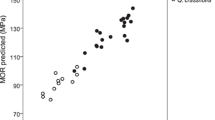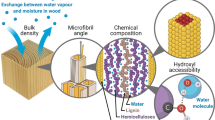Abstract
Characterisation of a number of key wood properties utilising ‘state of the art’ tools was achieved for four commercial Australian hardwood species: Corymbia citriodora, Eucalyptus pilularis, Eucalyptus marginata and Eucalyptus obliqua. The wood properties were measured for input into microscopic (cellular level) and macroscopic (board level) vacuum drying models currently under development. Morphological characterisation was completed using a combination of ESEM, optical microscopy and a custom vector-based image analysis software. A clear difference in wood porosity, size, wall thickness and orientation was evident between species. Wood porosity was measured using a combination of fibre and vessel porosity. A highly sensitive microbalance and scanning laser micrometres were used to measure loss of moisture content in conjunction with directional shrinkage on micro-samples of E. obliqua to investigate the validity of measuring collapse-free shrinkage in very thin sections. Collapse-free shrinkage was characterised, and collapse propensity was verified when testing thicker samples. Desorption isotherms were calculated for each species using wood–water relations data generated from shrinkage experiments. Fibre geometry and wood shrinkage anisotropy were used to explain the observed difficulty in drying of the different species in terms of collapse and drying stress-related degrade.










Similar content being viewed by others
References
Almeida G, Brito JO, Perre P (2009) Changes in wood–water relationship due to heat treatment assessed on micro-samples of three Eucalyptus species. Holzforchung 63:80–88
Bibiak M (2007) Chapter 4—Sorption isotherms of wood. In: Perré P (ed) Fundamentals of wood drying. A.R.BO.LOR, Nancy, pp 87–104
Bisset IJW, Ellwood EL (1950) The relation of differential collapse and shrinkage to wood anatomy in Eucalyptus regnans F.v.M. and E. gigantea Hook F. Aust J Appl Sci 2:175–183
Bootle KR (2005) Wood in Australia—types, properties and uses, 2nd edn. McGraw Hill, Sydney
Chafe SC (1985) The distribution and interrelationship of collapse, volumetric shrinkage, moisture content and density in trees of Eucalyptus regnans F. Muell. Wood Sci Technol 19:329–345
Cuevas LE (1969) Shrinkage and collapse studies on Eucalyptus viminalis. J Inst Wood Sci 23:29–38
Dadswell HE (1972) The anatomy of eucalypt woods. Commonwealth Scientific and Industrial Research Organisation, Melbourne
Guernsey FW (1951) Collapse in western red cedar. Br Columbia Lumberm 4:3
Harris JM (1989) Spiral grain and wave phenomena in wood formation. Springer, Berlin
Innes TC (1996) Collapse and internal checking in the latewood of Eucalyptus regnans F. Muell. Wood Sci Technol 30:373–383
Kauman WG (1965) Cell collapse in wood. CSIRO-Division of Forest Products, Melbourne
Nolan G, Innes TC, Redman AL, McGavin R (2003) Australian hardwood drying best practice manual. Forest and Wood Products Research and Development Corporation. www.fwpa.com.au
Pang S (2007) Mathematical modeling of kiln drying of softwood timber: model development, validation and practical application. Dry Technol 25:421–431
Pankevicius ER (1961) Influence of position in tree on recoverable collapse in wood. For Prod J 11:131–132
Perré P (2005) Meshpore: a software able to apply image-based meshing techniques to anisotropic and heterogeneous porous media. Dry Technol 23:1993–2006
Perré P (2007) Experimental device for the accurate determination of wood–water relations on micro-samples. Holzforschung 61:419–429
Perré P (2010) Multiscale modeling of drying as a powerful extension of the macroscopic approach: application to solid wood and biomass processing. Dry Technol 28:944–959
Perré P, Turner IW (1999a) A 3-D version of TransPore: a comprehensive heat and mass transfer computational model for simulating the drying of porous media. Int J Heat Mass Transf 42:4501–4521
Perré P, Turner IW (1999b) Transpore: a generic heat and mass transfer computational model for understanding and visualising the drying of porous media. Dry Technol 17:1273–1289
Perré P, Turner I (2007) Chapter 10—Coupled heat and mass transfer. In: Perré P (ed) Fundamentals of wood drying. A.R.BO.LOR, Nancy, pp 203–241
Perré P, Turner IW (2008) A mesoscopic drying model applied to the growth rings of softwood: mesh generation and simulation results. Maderas, Ciencia y technologia 10:251–274
Perré P, Wieslaw O (2007) Chapter1—From fundamentals to practice the interaction chain. In: Perré P (ed) Fundamentals of wood drying. A.R.BO.LOR, Nancy, pp 1–9
Perré P, Rémond R, Aléon D (2007) Energy saving in industrial wood drying addressed by a multiscale computational model: board, stack, and kiln. Dry Technol 25:75–84
Raymond CA et al (2008) Improving dimensional stability in plantation-grown Eucalyptus pilularis and E. dunii. www.fwpa.com.au
Redman AL (2011) Evaluation of super-heated steam vacuum drying viability and development of a predictive drying model for Australian hardwood species. Queensland Government Department of Employment, Economic Development and Innovation report for Forestry and Wood Products Australia. www.fwpa.com.au
Redman AL, Bailleres H, Perré P (2011) Characterization of viscoelastic, shrinkage and transverse anatomy properties of four Australian hardwood species. Wood Mat Sci Eng 6:95–104
Ressel JB (2008) Wood anatomy—an introduction. In: Perre P (ed) Fundamentals of wood drying. A.R.BO.LOR ENGREF, Nancy, p 19
Salin JG (1991) Modeling of wood drying: a bibliography. Dry Technol 9:775–793
Salin JG (2011) Inclusion of the sorption hysteresis phenomenon in future drying models. Some basic considerations. Maderas Ciencia y tecnologia 13:173–182
Savard M, Lavoie V, Trembala C (2004) Technical and economical assessment of superheated steam vacuum drying of Northern Red Oak. In: N.A.G.R.E.F. COST E15 conference, Athens, Greece, 22–24 April 2004, Forintek Canada Corp., pp 1–10
Siau JF (1984) Transport processes in wood. Springer, Berlin
Skaar C (1988) Wood–water relations. Springer, Berlin
Tiemann HD (1941) Collapse in wood as shown through the microscope. J For Res 39:271–282
Zieminska K, Butler DW, Gleason SM, Wright IJ, Westoby M (2013) Fibre wall and lumen fractions drive wood density variation across 24 Australian angiosperms. AoB Plants 5:14
Acknowledgments
The substantial contributions of AgroParisTech Nancy, Queensland University of Technology (QUT), Forest and Wood Products Australia (FWPA) and the Queensland Government Department of Agriculture and Fisheries (DAF), to the successful undertaking of this collaborative project are gratefully acknowledged.
Author information
Authors and Affiliations
Corresponding author
Rights and permissions
About this article
Cite this article
Redman, A.L., Bailleres, H., Turner, I. et al. Characterisation of wood–water relationships and transverse anatomy and their relationship to drying degrade. Wood Sci Technol 50, 739–757 (2016). https://doi.org/10.1007/s00226-016-0818-0
Received:
Published:
Issue Date:
DOI: https://doi.org/10.1007/s00226-016-0818-0




